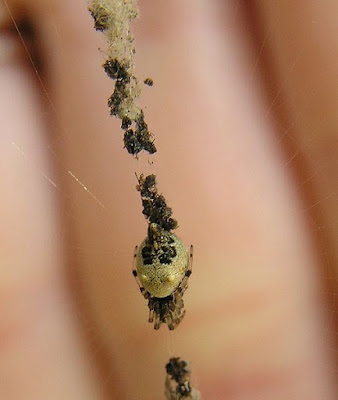Spider Dummies and Evolutionary Storytelling
Spiders are actually more intelligent that many people believe, and studies are showing this. If you study on the notion, you can see from the complexities of webs that orb-weaver spiders make, plus the specified complexity of their design to make the webs quickly and accurately. How about spiders that build dummies or decoys?
Not only do studies of spiders' intelligence and the web-making activities point to the work of their Creator, but two in the genus Cyclosa (in the Araneidae family) on opposite parts of Earth make decoys out of things that happen to be conveniently laying around. ("New species", meaning, "we haven't seen them critters afore now".) Sometimes they make very large decoys, other times the spiders add stuff to the web so they can hide in them. Working web threads to shake the dummies to bother predators is also utilized, probably so trespassers will light a shuck out of there.
At the time I am writing this post, the pictures on the article linked below are not appearing, but you can see some at this link.
Proponents of scum-to-spider evolution cannot provide an adequate explanation for the intelligence of spiders, their design, and their activities. Two species building dummies? Probably the secular miracle of "convergent evolution", or the equally vacuous non-answer, "It evolved". Creationists have some puzzle pieces to assemble, but their speculations are much more reasonable.
 |
| Credit: Freeimages / Odan Jaeger |
 |
| Credit: Wikimedia Commons / Lee Saborio via Angela Saborio (FAL 1.3) |
Proponents of scum-to-spider evolution cannot provide an adequate explanation for the intelligence of spiders, their design, and their activities. Two species building dummies? Probably the secular miracle of "convergent evolution", or the equally vacuous non-answer, "It evolved". Creationists have some puzzle pieces to assemble, but their speculations are much more reasonable.
Camouflage is a design feature used by many creatures to protect themselves in this sin-cursed world. Typically, camouflage is used to imitate an environment in order to blend in and hide.To read the rest and get the analysis of evolutionary guesswork, click on "These spiders aren’t dummies (or are they?)"
A related form of ‘deception for safety’ is called mimicry, in which a creature impersonates another species. For instance, to lower its chance of being eaten, it might imitate (in appearance, behaviour or both) a very unpalatable or poisonous species that a predator knows to avoid. Some creatures even mimic specific predators that frighten other predators away.
Recently, two independent studies have revealed a creature that mimics itself! And one could say it does so in a ‘big’ way.